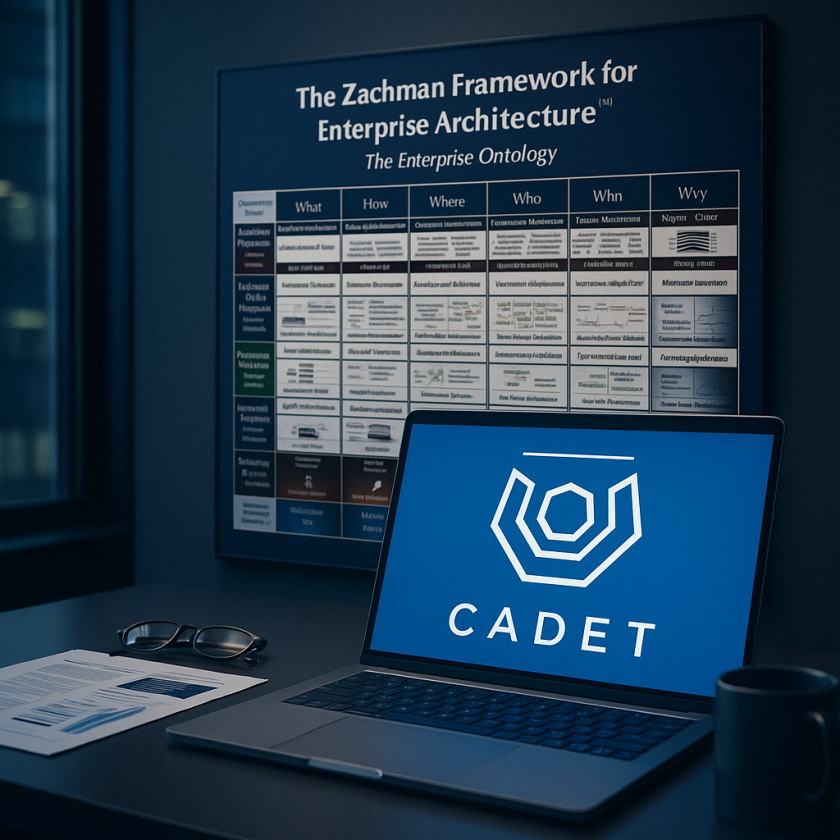
John’s clarity around the enterprise ontology has always been more than theory—it’s been a framework for action. It has changed the way we see, think about, and structure complex organizations. But what’s most important today is how this foundational thinking is finally meeting its moment—embodied in AI-driven platforms like CADET.
CADET isn’t just another tool. It’s the embodiment of Zachman-style intelligence, made actionable and accessible for government transformation leaders.
The Misconception We Must Overcome
In his recent article, John described the persistent myth that enterprise design “takes too long and costs too much.” It’s a Second Wave mindset—born in the Industrial Age, when building tangible, fixed-shape products demanded complete design before production.
But enterprise design doesn’t work that way.
As John reminded us, an enterprise can be operating—even at scale—even if it’s never been designed. Because the medium of enterprise implementation is the same as the medium of its design—paper or digital—it can remain perpetually unfinished. That’s the blessing. And the curse.
This is exactly the space where CADET lives. It doesn't require a grand enterprise overhaul before value is delivered. It works iteratively, incrementally, intelligently—aligned with Zachman’s foundational insight that enterprise design can (and must) evolve over time.
CADET as Living Ontology
CADET is powered by an internal architecture that respects—and activates—the 36 model types identified in the Zachman Framework. From scope-level planning to detailed representations of data, process, and timing, CADET doesn't just store information; it understands it.
It makes the relationships explicit. It builds traceability across stakeholder concerns, system components, motivations, and events. And it gives program leaders the ability to connect policy goals to execution-level decisions—through architecture.
To put it plainly: CADET uses the logic of Zachman to reduce the chaos of transformation.
From Insight to Action: The Enterprise Can Be Designed
John’s most provocative point may also be the most freeing: “The enterprise does not have to be completely designed… EVER.”
That means the argument that design takes too long or costs too much simply doesn’t hold up. With platforms like CADET, we’ve made it possible to start small, grow intentionally, and deliver measurable value—without losing the big picture.
This principle is baked into CADET’s service packs, including those for:
- Planning (APD-GPT) – Turning fragmented ideas into federally fundable deliverables
- Procurement (RFPGPT) – Generating compliant, needs-aligned RFPs in record time
- Data (System Landscape, Estimation, Fraud Models) – Creating enterprise-wide clarity about what exists and what it costs
To the Executives Still on the Fence
If you’re leading a digital transformation effort today, let me ask:
- Are you building your future on a foundation of structured, ontological insight—or simply adapting systems without a unifying design?
- Are you delaying design because you think it’s too big to start?
- Or are you ready to begin designing without starting over?
With Gratitude and Urgency
John, thank you—for giving us a vocabulary, a structure, and a way to think clearly about the complex. Your Framework continues to guide our steps.
For those of us delivering AI-powered transformation in government today, our work stands on your shoulders.
With CADET, Elyon continues to carry that work forward—empowering leaders to design smarter, govern better, and deliver with confidence.
The Zachman Framework has been more than a model — it’s been a mission. Your work has inspired us to help transform dozens of enterprises, touch the lives of thousands, and make a real difference in the way governments serve people. Thank you for giving us the structure and the courage to lead with clarity. Your legacy is alive in every transformation we help bring to life.








